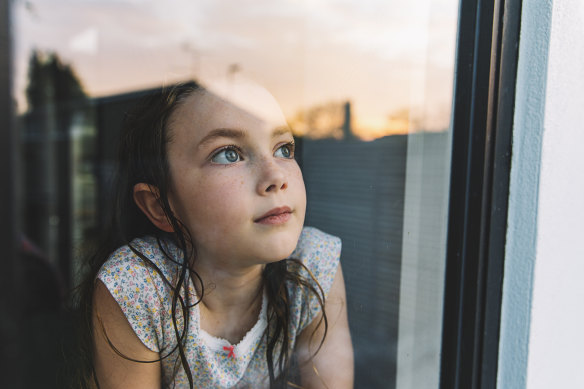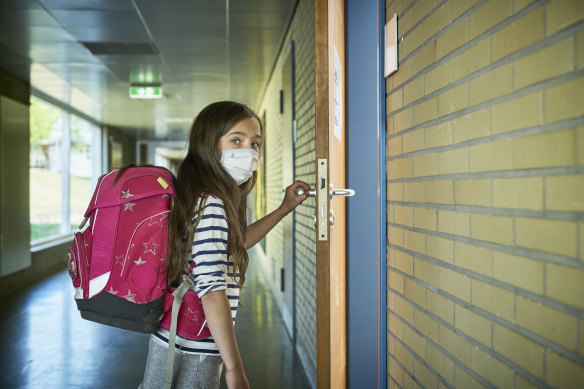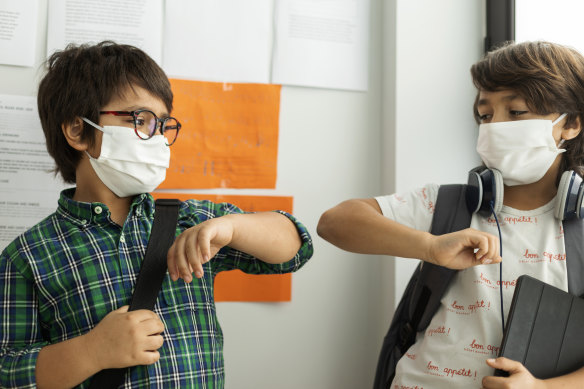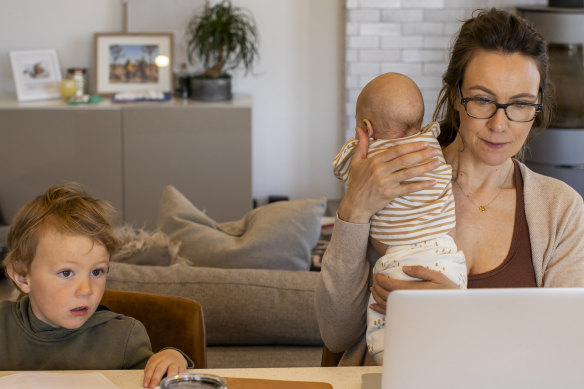Explainer
- Explainer
- Coronavirus pandemic
How does the Delta variant of COVID-19 affect children?
What does the evidence really say about the threat posed to children by the Delta variant of COVID-19?
By Liam Mannix
If the pandemic has had a silver lining up until now, it has been children. For reasons scientists still do not fully understand, they have been largely spared the ravages of COVID-19.
The numbers tell the story. The United States, one of the hardest-hit countries, has recorded 623,985 deaths from COVID-19. Just 385 of those have been in people aged 17 or younger – 0.06 per cent of the total toll. Fewer than 30 children in the UK have died from COVID-19.
Some 986 Australians have died of COVID-19. Just one of those deaths was in a person 19 or younger.
But Delta, the virus variant no one saw coming, has changed the shape of the pandemic. Countries that thought their vaccine programs had defeated the virus, such as the US and Britain, now face a new wave of infections they are struggling to control.
Does this variant pose a greater risk to children? The anecdotes are scary: children in hospital with COVID-19 in the US reached an all-time high of 1900 last week, although that’s only a tiny fraction of the 11,521 Americans admitted to hospital every day on average. Nearly one in five new infections in the US is now in children. Hospitals in several US states report they are running out of paediatric intensive-care beds.
Meanwhile, on August 27, scientific advisers to the Australian government endorsed rolling out vaccines to children older than 12, as the benefits outweigh the risks. However, due to the more limited benefits, the advice notes vaccinating this group is of a lower priority than vaccinating older adults.
The topic has become extremely upsetting, both for parents who are worried about their children and for experts who are worried the science is being ignored.
The federal Greens party, pushing for childhood vaccination, even put out a media release on Thursday titled “Won’t someone think of the children”.
A mood of panic has crept into the community, says Associate Professor Margie Danchin, paediatrician and immunisation expert at the Royal Children’s Hospital in Melbourne. “It’s important to get this data out there. There is this real groundswell of panic among parents.”
What does the evidence really say about the threat posed to children by the Delta variant of COVID-19? Should we be vaccinating them? Are we leaving them unprotected?

Credit: Getty Images
Is Delta making kids sicker?
First, let’s start with the evidence for children and COVID-19 for previous variants. In general, COVID-19 is a very mild illness for children.
“They can catch infection easily but most cases have no or mild symptoms. You might not even know you’ve had COVID-19,” says Robert Booy, professor of child health at the Children’s Hospital at Westmead.
The data bears this out. Of 393 children who presented to hospitals with COVID-19 in 2020 in Australia, just 44 children were actually admitted and the rest were sent home. More than a third had no symptoms. In 4 per cent of cases, a medical intervention was necessary.
Which brings us to Delta.
More children are becoming infected with Delta, experts say. This is because it is a more infectious variant: everyone is more likely to be infected by it.
The evidence remains the same: for children, COVID-19 is a mild illness.
“In terms of ICU admission and deaths, there is no indication in the data,” says Professor Danchin. “We need to be calm. We don’t want parents panicking that there’s going to be a huge wave of serious illness in children.”
“Overall, parents need to know that kids still mostly get mild disease with a sore throat, runny nose and fatigue mostly, like a nasty cold, but they are very unlikely to get sick.”
This is important, so let’s hear it again. “The evidence shows, to the best of our knowledge to date, COVID-19 – even with Delta – remains a mild illness for children,” says Royal Australasian College of Physicians president-elect and paediatrician Dr Jacqueline Small.
Let’s go to the data.
In November, a month before Delta was detected in the US, 1.8 per cent of people hospitalised there with COVID-19 were children. Cut to this month, and that number has risen to 2.3 per cent.
“Data from the UK and other countries such as India also show the same – no increases in ICU admissions and deaths with Delta, and much lower rates than in adults,” says Professor Danchin.
One infant is in hospital with COVID-19 in Victoria, the state government said on August 23. In NSW, between June 16 and August 7, there were 41 people aged 17 or younger in hospital with COVID-19 out of a total of 759. On September 5, three children, including an infant, were in intensive care with COVID in NSW.
In August, more of Victoria’s COVID-19 cases were recorded in schools and childcare centres than any other type of setting. However, this simply shows the virus is more infectious overall – not that it is specifically targeting children, says Professor Booy.
“Delta is incredibly transmissible. It goes for the people who don’t have immune protection. We’ve seen far less disease in the elderly because they are vaccinated. So of course we expect to see, and are seeing, infection and disease in children. What we are not seeing is very serious disease.”
All this adds up to the conclusion of the Doherty Institute’s modelling for reopening Australia: in the first six months after we reopen at 80 per cent vaccination, of 762 deaths predicted (most of whom will be unvaccinated), 25 will be in children under 16. However, this model assumes that no one under 16 will be vaccinated, which is not the case, with vulnerable children aged 12 to 15 already eligible and a rollout still to happen for all 12-15-year-olds.

Credit: Getty Images
If Delta isn’t making kids sicker, why are more of them in hospital?
To understand what is going on, we need to think clearly about infection statistics – and appreciate the role of another ignored virus.
Delta is substantially more infectious than earlier variants of the virus. The Delta variant is about 60 per cent more infectious than the Alpha variant of the virus, which in turn was about 50 per cent more contagious than the strain of the virus that emerged in Wuhan.
That means everybody is more likely to get sick — more adults, more children.
“There will be more infections in children and young people who are unvaccinated. There is no evidence, as yet, that Delta is making children more sick,” says Professor Fiona Russell, a paediatric infectious diseases epidemiologist and vaccinologist at the Murdoch Children’s Research Institute.
At the same time, vaccine programs are progressing around the world. These programs have typically prioritised the people most vulnerable to the virus: the elderly. Some 88.7 per cent of Americans over 75 have been vaccinated versus just 17.6 per cent of those under 18.
While vaccines are not 100 per cent effective at preventing infection, they substantially cut the risk of catching COVID-19. By giving them to adults, we dramatically cut their risk of catching COVID-19. So, simple statistics tell us that children will make up a bigger proportion of cases now than they did earlier in the pandemic because they make up a bigger proportion of unprotected people.
But this does not mean Delta is making kids sicker. The US data is “being taken completely out of context”, says Professor Danchin.
The effect that vaccination has on making the virus look like it is targeting children can be seen in Victoria’s infection data.
In July and August 2020, the peak of Victoria’s second wave, people 19 and younger made up 16.4 per cent of diagnosed cases.
Between July 1 and August 23 this year, people 19 and younger made up 37 per cent of cases.
Why? In part because in July and August 2020, people aged over 70 made up 13 per cent of cases. In July and August 2021, they made up just 0.9 per cent.
This is evidence that a) the virus is more infectious and b) the vaccines effectively cut your risk of catching it.
There is a third issue warping the situation in the US to make Delta look worse than it is for children: respiratory syncytial virus, also known as RSV.
A largely harmless seasonal virus in adults, it can cause severe infection – leading to hospitalisation – in children younger than one. About 58,000 American children are hospitalised with it every year.
”It happens every winter and fills the hospitals up,” says Professor Russell.
RSV, like COVID-19, is a respiratory virus. That means lockdowns and masks also inhibit its spread. RSV was almost absent in 2020. When restrictions lifted, it came back with force.
Australia experienced a surge early this year, says Professor Russell, when, luckily, there was little COVID-19 around.
The US is being hit with both RSV and COVID-19 at the same time, putting the paediatric healthcare system under serious strain. This is one of the major drivers of children’s hospital beds filling up in the States: not COVID-19, but RSV.

Credit: Getty Images
Why do children tend to be less sick from COVID?
The protection that children seem to have to COVID-19 is unexpected. Typically, they are most at risk from respiratory viruses.
Teams around the world are still trying to figure out why this is. One possibility: the powerful innate immune system. This system operates as a first line of defence before a virus can even begin to replicate. Children generally seem to possess a much more powerful innate system than adults. Work by Dr Melanie Neeland, published in Nature Communications, shows a much greater activation of the innate system in children with COVID-19 than in adults.
A second possibility: antibody studies show children “tend to display a more targeted antibody response to this virus” than adults, says Dr Neeland. This could be because adult immune systems have already had to fight off the coronaviruses that cause the common cold; memories of this virus may lead them to create less effective antibodies. Children appear not have this problem.
What about long COVID?
Children appear to be at substantially decreased risk of contracting long COVID.
About 13.3 per cent of adults who catch COVID-19 have symptoms for at least four weeks, and 4.5 per cent have symptoms for at least eight weeks.
In children, only 4.4 per cent have symptoms past four weeks, and just 1.8 per cent past eight weeks, according to a large Lancet study.
“Our findings should be broadly reassuring,” wrote the paper’s UK-based authors. “For most children, COVID-19 is a short-lived illness.”

Credit: Getty Images
Aren’t kids just little walking Petri dishes? Do we need to vaccinate them to get to herd immunity?
The evidence on how much children pass the virus on remains very contested – so much so that a large study by Professor Booy published in JAMA Pediatrics in February found the evidence was too weak to draw any conclusions at all.
The Murdoch Children’s Research Institute concluded that children over 10 transmit the virus at similar rates to adults, with younger children likely transmitting it less; modelling by the Doherty Institute for the federal government concluded that vaccinating this age group would have almost no effect on slowing transmission of the virus.
Schools appear to be far less of a threat than is popularly believed. Although the evidence is weak, it suggests transmission at schools is very low, the Murdoch institute concluded. Outbreaks at schools tend to be driven by outbreaks in the community, not vice-versa.
How can we protect children?
One answer is vaccination. In March, Pfizer claimed its vaccine was 100 per cent efficacious in children aged 12 to 15, based on an unpublished clinical trial of 2260 adolescents. The vaccine is approved by the Therapeutic Goods Administration for children 12 years and older in Australia. The federal government has said children older than 12 will be vaccinated at some point but is awaiting scientific advice on when to add them to the rollout schedule.
How we should prioritise children for vaccination remains a point of sharp ethical debate.
The Murdoch Children’s Research Institute is calling for children over 12 to be added to the rollout when supply eases. “Certainly, for over 12s, the consideration needs to be in terms of school opening. It’s not just primarily based on the health. We have to get schools back,” says Professor Russell.
But Professor Booy, from the Children’s Hospital at Westmead, views the Murdoch institute’s position as unfair and inequitable. Just 1.4 per cent of people in low-income countries have received a jab, according to ourworldindata.com. There are not enough vaccines for everyone in the world to get one until 2023, according to one projection; every vaccine given to an Australian child is one less that can be given to, say, a nurse or doctor in Indonesia.
At this stage, there is not enough clinical data about the safety and efficacy of COVID-19 vaccines to offer them to children under 12. Trials from Pfizer and Moderna – both vaccines Australia has purchased – are under way.
While children remain unvaccinated, several experts say the best way to protect them is to ensure the adults around them are vaccinated.
Most cases of COVID-19 are transmitted in the home, and children typically catch the virus from adults, not other children, says the Royal Children’s Hospital’s Professor Danchin.
“Children are most likely going to be catching the virus in the household,” she says. “It is the best thing people can be doing now, if they are concerned about their children – getting themselves vaccinated.”
This explainer was first published on August 26 and has been updated to reflect developments.
correction
This article originally stated 11,521 American adults were admitted to hospital every 7 days. In fact, this is the seven-day daily average. On average, 11,521 American adults are admitted to hospital with COVID-19 every day, per CDC data. https://covid.cdc.gov/covid-data-tracker/#new-hospital-admissions
Let us explain
If you'd like some expert background on an issue or a news event, drop us a line at explainers@smh.com.au or explainers@theage.com.au. Read more explainers here.